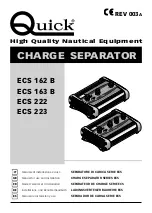
IV. Using the System
Once the filters have settled and it is ready for use, run the drain line into the sink/drain. Your Aquarium
water tube will then run into a container or tank to fill with fresh filtered DI water. It is recommended to keep
the container you are filling in a water safe area – for example on the sink top in case of spillage (or more
commonly – if it overflows because you forget you turned it on) so you don’t come back to a flooded room.
A handy tip is to use a timer the first time you use the unit and note how long it takes to fill your desired
storage container. Each time you start using the system, open the manual flush valve for up to a few
minutes to clear any potential TDS creep – monitor this by using the TDS meter ‘inlet’.
V. Manual Flush Valve for TDS Creep
The GT1-39RODI system includes a manual flush valve built in to the flow restrictor to flush the membrane
and clear any residual TDS as a result of ‘TDS Creep’. TDS creep is the result of salts ‘wicking’ through the
membrane into the permeate line while the membrane sits in stasis. This increased TDS would normally
flush through into the DI filter; the flush valve allows you to open the drain line and flush all this water to
waste until the TDS balances back to normal levels. This prolongs the life of the DI resin media.
To operate the manual flush correctly, do the following steps.
1. Set the TDS monitor to the inlet setting
2. Open the manual flush valve so the handle is running inline with the flow of water.
3. Turn on the incoming feed water and allow the unit to flush to waste for up to 90 seconds.
4. Close the flush valve and monitor the TDS levels on the TDS monitor to ensure they are at or below
the desired level.
5. If the TDS level is still too high, open the flush valve for another 30 seconds then close and check.
VI. After Use & Storage
The system can then be stored away in a cabinet – if you have a plastic container or tub to put it in it is
ideal to prevent any water leaks. You can also get plug fittings for the ends of the tubing (not supplied) to
keep the system airtight.
VII. Long Periods of no use
If the system has been in storage for longer than a few days, it is best to open the manual flush valve for up
to 5 minutes then close it & run the unit for 15 minutes before collecting the water or until the water TDS
stabilises. Bacterial contamination is not usually an issue with intermittent use but is possible after over a
month of storage. If there are any smells, tastes or changes to the water quality it is best to replace the filter
cartridges and start fresh to avoid any possible issues.
TDS Monitor
I. What is TDS
Total Dissolved Solids (TDS) are the total amount of inorganic elements, including minerals, salts or metals
dissolved in water, other than the pure water molecules (H2O) and suspended solids. A TDS meter works
by measuring the total amount of mobile charged ions dissolved in a given volume of water, expressed in
total quantity as parts per million (ppm), or in weight as mg/litre. TDS is directly related to the purity of water
and the quality of water purification systems. TDS affects everything that consumes, lives in, or uses water,
whether organic or inorganic, for better or for worse.
II. Installation
The DM-1 can be configured in a variety of ways, depending upon your needs. Typically, the IN line (line 1)
is connected to the source (tap) water, and the OUT line (line 2) is connected to the product (filtered) water.
The DM-1 can also be configured with multiple systems, such as an RO/DI combination, as well as with HM
Digital’s Single Inline TDS Monitor (model SM-1).































